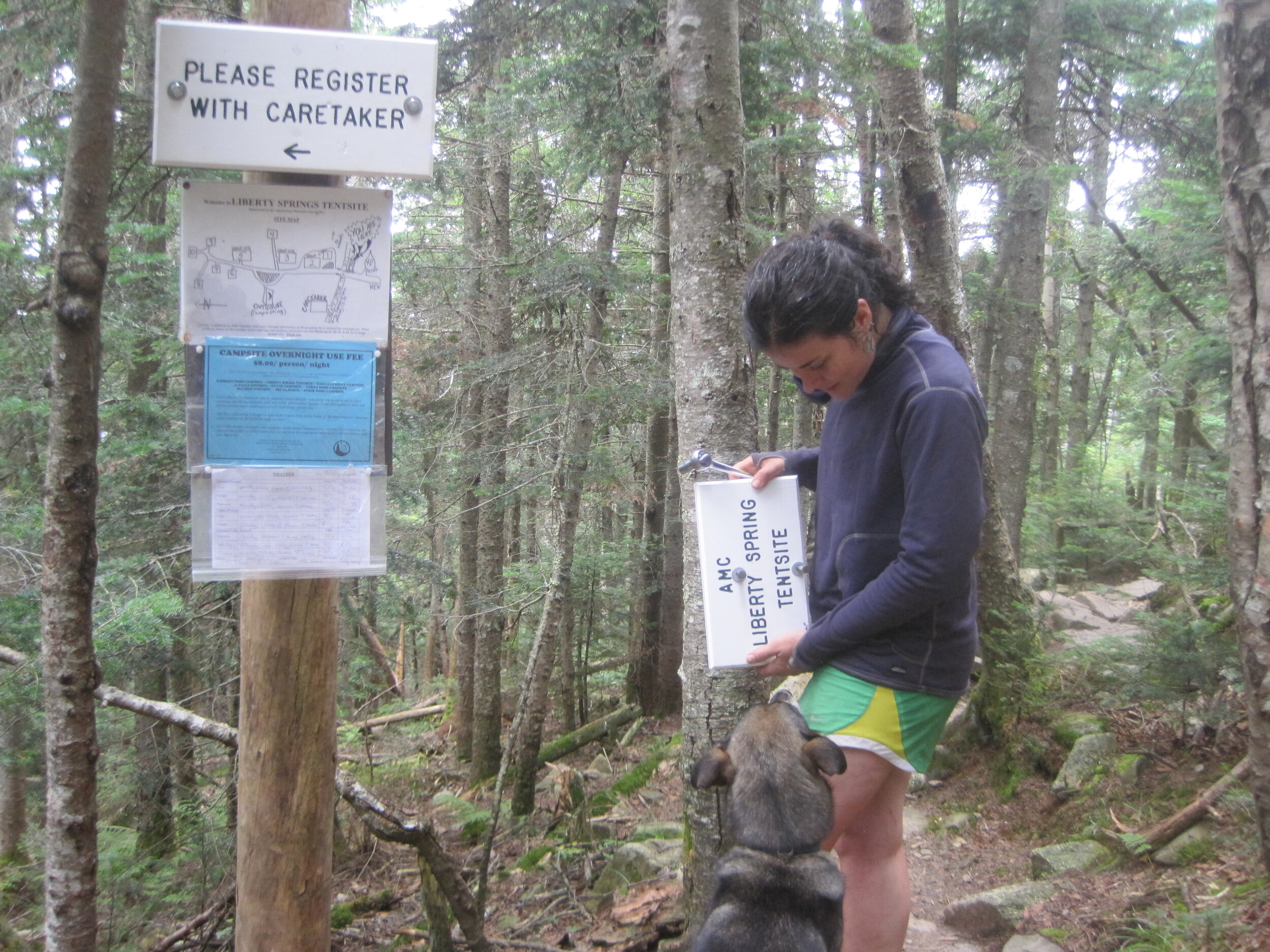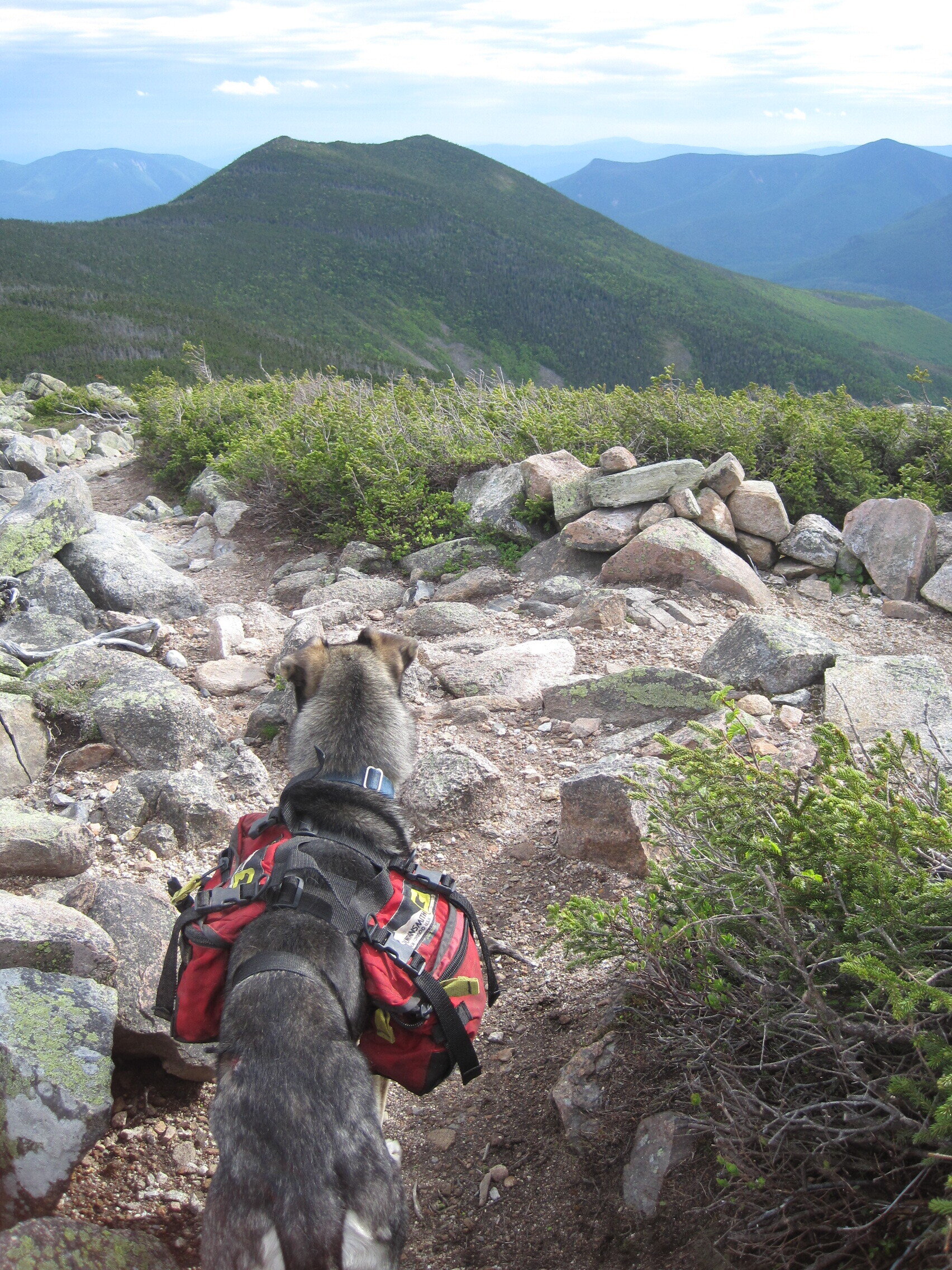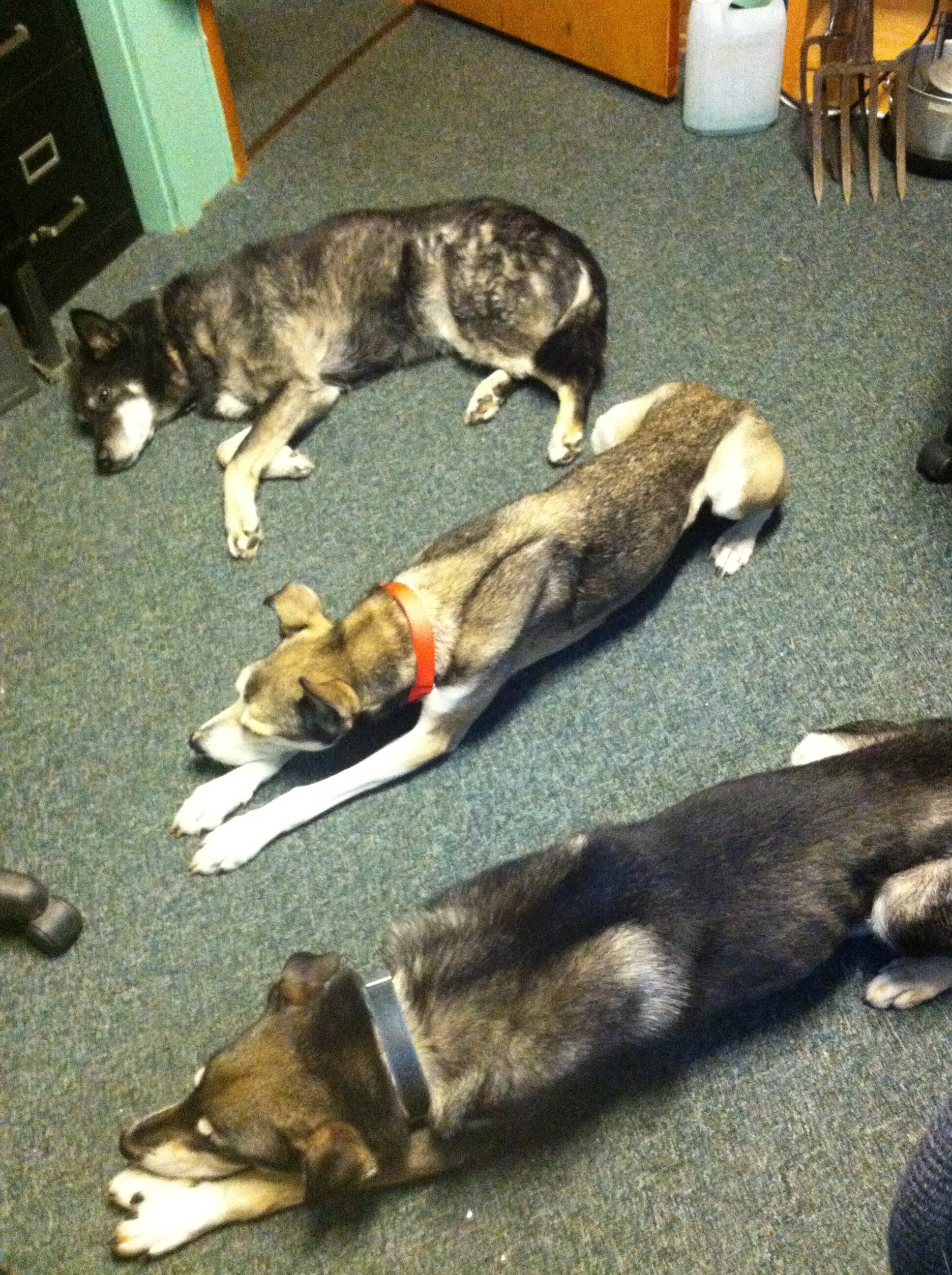Plexico
7/2006-1.14.2021
With me since April 2012, house dog since 2013
‘Who’s that?’
The clean gray and white, the two spots of eyebrows, the perfectly symmetrical ears and the big brown eyes. Calm, but something else, waiting.
‘That’s Plexico’
Trailside. 3Sixty/ Bruce Luetters photo, 2015.
I first noticed Plexico in 2009, calmly poised in front of his house. It was the first dogyard I’d seen outside of the large kennel where I had done tours for three years, the first time I’d seen other dogs. Race dogs. The dogs of a musher. I went up to say hi to Plexico, and the calm poise dissolved, and he exploded with energy as he glued himself to my body and flung his paws at my chest.
Plexico represented something to me, at that time. He was the kind of dog valued by the musher who bred him, with a clear story and history of his parents and lineage. He was smooth, muscled, and just plain handsome. But also, I picked up on something from him, a combination of heart and mind, and personality. I picked up on the things that drives the instinct of a musher to focus on the dogs they like: a connection with the dog themselves.
Scott helped me start my team, giving me dogs from his yard in 2011, and six months later in the spring of 2012 offered me Plexico. Even though he was six years old, even though his back end was mangled from a bad fight, I enthusiastically said yes. I didn’t know what kind of racing I wanted to do, or how to pick dogs for the races I wanted to run, but I did know that Plexico and I were meant to be together.
Proof that Plexico lived outside. And evidence of how much he wanted to always dig into me.
As a sled dog, Plexico was easy for me to handle, and helped me realize that it was important for all dogs to be easy to handle. If I cut him loose from the dog yard, and a box in the truck was open, he would run from his house and self-load into the open box. Somewhere there’s a video of this, taken by someone else as I loaded the dogs for an evening fall training run in 2012. Plexico ran with anyone, never chewed a line, and cheered his way through the run. On the very first training log I created, that fall of 2012, Plexico had the most miles of any dog on the team, because I loved him and because he was easy to deal with, not necessarily because he was the best athlete on the team.
The winter of 2012-2013 was the year I broke my ankle in November, gutting the training plan I had for racing 100 mile races. When I got back on the sled in February, quickly whipping a 30 mile team into shape, I found myself not choosing Plexico for the six dog race team. Watching him in the team, I sensed something, saw something as he pulled off to the side, backed down from his line. My training log doesn’t note specifically what I saw at the time, but evidence shows him being cut from the team, as I added different dogs with strengths more suited to 100 mile races.
I could have easily placed Plexico as a pet. I didn’t have to keep him. Something, that same something I’ve always known, had me bringing him into the house, making him a permanent companion. Perhaps this was the route I always wanted to take with him, perhaps this was the route he always wanted, from that morning in 2010 when he glued himself to my body. If Quid had represented wildness, a desire for my 20-something self to run rangy and raw, Plexico represented (maybe a little too cleanly) that my 30-something self desired something different: stability, reliability, love, and a constant. I don’t think it’s a coincidence that Chuck and I had our first date the first week Plexico came inside.
At the time, Quid was the sole inside pet dog. Quid was difficult, challenging, and independent. Plexico was the exact opposite. They lived in a contrasting co-existence, not really becoming friends but tolerating each other’s differences. Quid ran from my emotional distress, Plexico stuck his body to my side. Quid displayed selective hearing and a ¼ mile radius wander-zone, Plexico stayed so close to me any photo of him usually included my leg or foot. Quid looked at me with impatience, Plexico looked at me with pure and total love, and nothing less. Plexico seemed to respect her and Quid seemed to tolerate him, and honestly I think Quid appreciated that Plexico could bear the brunt of most of my needs, allowing her to do her own thing and be her own dog. Quid was 13 at the time, and was starting to not be able to make the longer hikes, the bigger trips, and Plexico stepped in.
That summer of 2013 Plexico went with me everywhere, not because he asked but because that’s where he belonged. He sat under my desk in my office, he hiked with me on long backcountry field visits, he sat with me outside on the porch, he lay just out of the danger zone as I cut firewood. Anytime I was outside, Plexico followed me from window to window, destroying screens and windowsills as he attempted to get back to me. Eventually I let him follow me around outside, knowing he wasn’t going anywhere. Plexico refused to accept any barrier to me, even a few feet of air space: he wanted to be as close to me as possible, to crawl within me if he could. I welcomed it, and honestly encouraged it, as I needed and wanted it too.











Happily in my bed, the place he belonged.
As befits a spoiled companion dog, Plexico slept with me in bed, his face the last thing I saw before I fell asleep. Plexico would curl up against my chest, his face against mine, sometimes him tapping my face with his paw if he needed me to keep petting him, until we both fell asleep. Much to Chuck’s chagrin, Plexico would continue to wedge himself between us, refusing to give an inch of space. When I would travel, Plexico would insist on sleeping in my bed, surrounded by my smells. Most importantly, when I had my big crash and concussion in 2015, Plexico refused to leave my side, growling at Angela as she dragged him off the bed to get him to go out and get him to eat something.
This pure love and devotion to me was accompanied with a personality that didn’t work for everyone. Plexico was a little bit of a grump, yelling at my sister’s cats, yelling at my brother, yelling at puppies that came inside. He destroyed furniture not out of boredom but in his rush to get outside to me, scratching his way across the side table. I laughed at his attempts to yell at Grenade, who ignored him and sometimes would sit right on top of him on the couch. Chuck saw him as a rival for my affection, which, honestly, he was at first. But there he was, with his gentlemanly poise, crossed paws, and handsome clean face.
Plexico is immortalized in a handful of interesting places. First in the Appalachian Mountain Club video ‘hiking with dogs,’ where my friend Ryan Smith patiently directed me, while Plexico got every direction on the first take: drinking out of two different kinds of water dishes, walking in a straight line with booties, jumping in and out of the car at the trailhead. Around that same time, I had my first of many photo shoot experiences with Bruce Luetters. Just as Bruce captured Grenade’s beauty and spirit perfectly in her impish face, he also captured Plexico’s devotion to me. Plexico can be spotted in every single series: standing with me in the shed, lying at my feet in the front room, sitting in the chair with me, and my companion in the trailside shots. In all of those, Plexico pushed his way past the doors and human barricades to get to me—we hadn’t planned on him being in the shots.
Portrait by Bruce Luetters, 3Sixty. Plexico wasn’t supposed to be part of this, but he pushed himself in and insisted on lying on the floor at my feet.
Plexico and Grenade on the couch, with House, Wembley and Ariel on beds. 2018.
Plexico not-so quietly tolerated the parade of sled dogs that came into the house. In almost every photo of the sled dogs arranged on dog beds, you can see him looking over the sea of other dogs directly at me with a slight degree of exasperation. He never interacted with them, and stayed focused on me. Looking back at the series of sled-dogs-inside photos, I can track the history of the team itself: photos that first included Brynnie (a leader who was here for only one winter in 2014), and then Tawhio and Maihi, and then Wembley and House, a few visits from Hilde, then Ariel appears with Hyside and Foreman, and then finally the Princesses themselves: Aurora and Ariel. From the starting arc of the dog team until where we are now, Plexico was there, refusing to share his couch.
Surrounded by dogs who had a different connection to me, who I looked at and saw the trail and the team, looking at Plexico was an extension of my person. Plexico was my companion on evening walks, lunchtime hikes, lunch breaks outside. He was, what I assume, most pet owners experience, a dog who’s purpose is companionship, pure and simple.
Did I take him for granted? Assume his constant presence and generous love? I think it was less that I assumed, or didn’t appreciate, but he zippered himself so deeply into my presence it’s like asking if we give constant thanks for our arms and legs. Maybe we should give more appreciation for the things that make our lives livable.
My constant porch companion in the summertime, for breakfast, lunch, and dinner. If I was outside, he needed to be outside.
The common story of aged decline impacted Plexico's ability to be as close to me as possible. Growing unsteady on his feet, Plexico was forced to stop sleeping in bed with me when he started falling down the stairs, when he was probably 10 years old. The adaption of couch co-habitating was an insufficient but accepted substitute for sleeping by my side. The two places I could always count on Plexico to be were lying on my lap in the evenings while watching TV, and outside on the porch in the summertime.
At the same time, this shift in his habits brought him into a routine less dependent on me, into relationship with the rest of the house. My sister Caroline took care of him, David changed his couch cover and fixed it, and both of them let him in and out. Honestly, this was better and more realistic than the extreme co-dependency he and I had been in, and he settled into his new routines.
For four years, Grenade and Plexico were twinned, an odd couple of retired dogs, when Grenade retired in 2016. Grenade never really gave up her sled dog ways, her mind always on the trail and her perfectly fine-tuned athleticism standing in contrast to his increasingly crippled movement. Grenade always looked for a way to beat Plexico off the couch, catching him off guard if he got up and leaping onto the couch with an enthusiastic roll while he looked at me despairingly before jumping up and sitting on her. Chuck would take Grenade and Plexico for walks, and sometimes video the race back to the house with his own color commentary (believe it or not, but Plexico would beat Grenade every time).
The scar tissue mapped across his back end stiffened his joints as he aged, eventually seizing his hind legs into an unbending straight line. He could only sit with his hind legs straight out underneath him. Unable to sit in his beloved sphinx pose limited where he could rest, kept him from lying on the porch with me or spending hours outside with me. No longer chasing me from window to window, Plexico would still greet me at the door, and insist on following me outside in the summertime.
At 14 years old, stiff and pained, he still held onto the things most important to him, and throughout the 10 months of COVID he and I did the things we’ve always done together. There were many outside porch mornings, lunch breaks, and cocktail hours. He would come over to me when I was outside hanging laundry, working on my saw, or gardening. His romping through the front yard would bring a smile to my face, as he followed his route down the driveway, up past the clothesline, over to the compost, and then back behind the house to the front door.
Unable to lie down, he would stand in my orbit as long as he could bear it, before giving up and going back inside to the couch. When I would go out to the porch to sit, there was sometimes a delay before he’d get up off the couch, but I could count on him coming to the front door, demanding to be at my side, before heat and his unsteady legs drove him back inside to the couch.
January 2021, only a week before he died, during a mid-day outside romp.
I knew Plexico was getting older, and I knew in the next year or so we’d reach that decision point. He had survived vestibular disease, he pooped constantly on the couch, he moved stiff legged through life and it seemed like maybe the time would never come. This fall, when I moved the dogyard to Upton, I thought long and hard about whether I should bring Plexico with me. I knew our time was short. But I also knew that he had a perfectly-controlled environment suited for him in Shelburne. I left him with my family, and his couch, and spent time with him when I was in Shelburne. I bought him rugs to cover the slick hardwood floors, raised his water dish to reach his face. It fell on others to care for him in the day to day. This was not easy.
Then, one week, the old dog signs of transition arrived. Something was out of whack, and he had stopped walking without support and wasn’t eating. I made him comfortable and sat with him, walked him gingerly to the door and used a leash for the first time to guide him. I didn’t know what was going on, but I knew he wasn’t ok. As I sat with him, connected with him, we both had the clear understanding that it was time, that we were prepared. There was nothing but love in his eyes, and in mine.
I made a bed for Plexico in the front seat, including a bolster for him to rest his chin, and we went into the vet. Fortunately, or coincidentally, the one side he could lay on gave him a perfect view of me. For the entire 45 minute ride to Lancaster, and the two hours we spent in the car in the parking lot, he was relaxed. I was all his, and only his, which was all that he ever wanted. Those hours together were timeless, those hours together held the love of all our years together. I kept my hand on his ears, and he kept his eyes on me. He never liked being brushed, but I tried to clean him up with my fingertips.
When the sedative hit his body, I held his face and shoulders. As he fell, I tore my jacket open, holding his face deep against my chest, so that every single sense, his failing vision, his nonexistent hearing, whatever strength of smell was left, drank in everything I had. I followed him all the way to the floor.
‘I love you too,’ I said, in a response, because all I ever could do was respond to the love he already gave.
--
I lay in bed when I got home. Even though he hadn’t been in bed with me for years, I felt him, solid and present. I saw him, curled up against the pillow over the blanket. I saw him as his younger self. I kept putting out my arm, reaching for him, reaching for the comfort of the dog who used to comfort me. I saw him, but also saw him gone.
I really shouldn’t be surprised that Plexico’s presence has lingered like that. It’s not movement, it’s not noise, it’s not the empty space on the couch, it’s this ball of love and devotion I feel at times glued to my side. He was always there, for me.
I love you too, buddy. Thank you for being there, for being always there.





















































